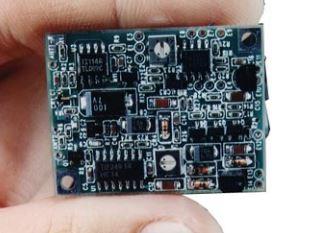LLNL's micropower-impulse radar (MIR) presents a new paradigm in radar technology. MIR uses $10 of off-the-shelf components to outperform conventional radar and sensor equipment costing as much as $40,000. Both the radar transmitter and receiver are contained in a package measuring just two square inches.
The technology is an outgrowth of the world's fastest solid-state digitizer, which was designed to measure sub-nanosecond events generated by fusion experiments on the Laboratory's Nova laser. MIR is based on the radiation of short voltage impulses that are reflected off nearby objects and detected by MIR's extremely high-speed sampling receiver. Prototype units emit one million impulses per second and then detect their echoes within ranges of 20 feet, or further with the addition of synthetic beam forming antennas. The microradar can be preset to detect stationary objects within a precisely defined range as well as any motion within that area. MIR can penetrate materials such as rubber, plastic, wood, concrete, glass, ice, and mud.
- Unique, patented technology
- Compact
- Inexpensive
- Wideband pulsed radar
- Low power
The technology already has been licensed for electronic studfinders, automotive safety products, and industrial automation. Discussions with hundreds of interested companies indicate there are many products that will be improved and reduced in price by MIR. Below is a partial listing of the many other fields-of-use that are available for licensing.
- Residential, commercial, and industrial automation
- Security and energy conservation
- Fluid level sensing
- Transportation
- Medical
- Radar imaging
- Material evaluation
- Tools
- Voice recognition equipment
- Communication
- Underground detection
- Military, including buried mine and ordnance detection
We are not an equipment manufacturer; therefore our goals are to (1) license MIR to qualified companies who can develop products, (2) continue to develop variations of the MIR for our Laboratory mission, and (3) seek out new ideas for future directions of this exciting technology.
FCC Summary and Regulations
Licensees of LLNL technology are solely responsible for obtaining any regulatory approvals that may be needed to practice the technology. LLNL cannot advise nor assist any company in obtaining such approvals. Refer to the Executive Summary of the FCC Order 4-22-2002 covering Ultra-Wideband (UWB) devices and the FCC Rules & Regulations that apply to the MIR technology.

